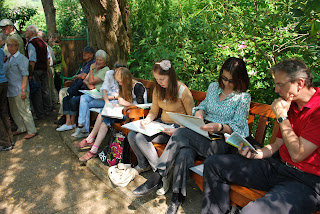




I named my first cat Claude, in honour of Claude Monet, the French Impressionist painter. My second to last cat was named Monet, for the same reason. I've always loved the impressionist painters since I was introduced to them; it's just that I can't remember when or the situation. Maybe it was the art class at Teachers College, maybe it was high school- that's more like it. Renoir, Degas, Monet. The others too but Monet stood out because he painted his garden and his garden was created as an inspiration for his painting. I had cheapish prints in my home for years until they all turned blue from the light. I always wanted to see his famed garden.

Last Sunday I did just that. It was a bit of an expedition. The drive to Giverny required a lot of patience in the Easter traffic and there were the inevitable toll stops requiring payment. Travel sickness was an unwelcome companion too. We stopped off and munched some sandwiches we'd brought and then, somehow, managed to find the village of Giverny. It's small, above the Seine west of Paris.

I'm impressed with the river Seine. I'd thought it was all about Paris. In reality it defines much of the countryside in the Ile de France and Normandie. It's majestic, beautiful.

Parking was extremely frustrating. Although it's early in the tourist season the place was packed and Jean-Claude practically created a car-park in order for us so we could get out. Parking is free. The entrance fee gives access to the waterlily pond, the house and the various garden areas. You pay extra if you want to visit the Impressionist museum. We didn't do that because the crowds were getting to us.

The lily pond is beautiful but the trees and humanity have a way of depositing in it so a boatman was busy skimming. I suspect in Monet's time (the beginning of the twentieth century) there was more admiring and less skimming. At this stage of thge season there are no water lilies to admire but that didn't matter to me. The garden grows right to the edges of the pond and there's colour everywhere. The colour combinations throughout the complex are amazing, there's little room for weeds to grow, but the business of keeping it all looking tidy and colourful 364 days of the year requires 30 gardeners working at night.

There was the Japanese bridge smothered in tourists having their photos taken on it, the rododendrons and azaleas, tulips and forgetmenots, pansies, maples, peonies...
The main gardens near the house are rather too structured for our tastes. They are rectangular beds with everything in straight lines. There's no veggie garden these days- just espaliered apples and some chooks. It's all very organised and congested with people- you feel like you are on a production line being moved forward so it's difficult to stop and admire with the masses bumping and pressing but we tried. I took a few patient minutes out to photograph JC on the bridge which really was delightful with the wisteria cascading down.

Monet's house lacks some of the homey touches he would have had and is even more difficult to see full of people but the kitchen was very interesting with its blue and white theme, the dining room in lemon, his bedroom sporting a very small bed for two but typical of the times. Monet's workshop/display area for his waterlily series has been turned into a shop. There's a display of Japanese prints but they don't interest me.

I'm glad I went. I loved the flowers and I loved finally being on the same hallowed ground that the great painter once worked in. I hope you'll enjoy the photos as much as we did seeing the inspiration for them.
The photos are self-explanatory but note the keen budding artists drawing the famous bridge over the pond. It's a shame I can't fit more photos into this blog but a blog needs balance between photos and text.




















































